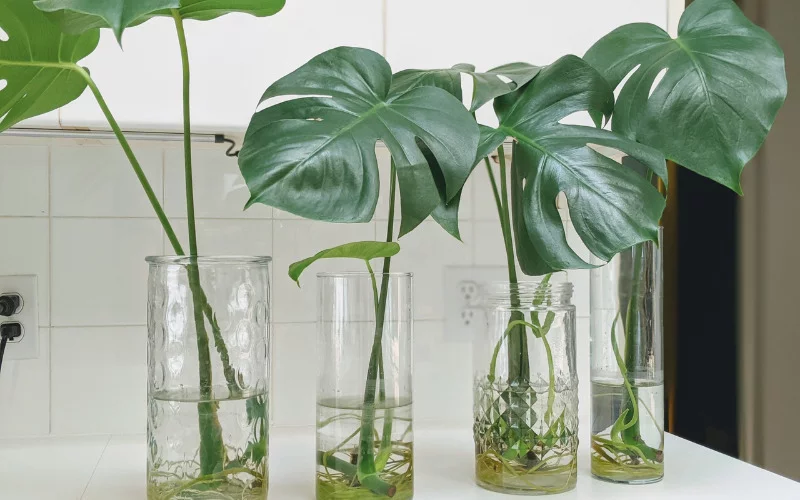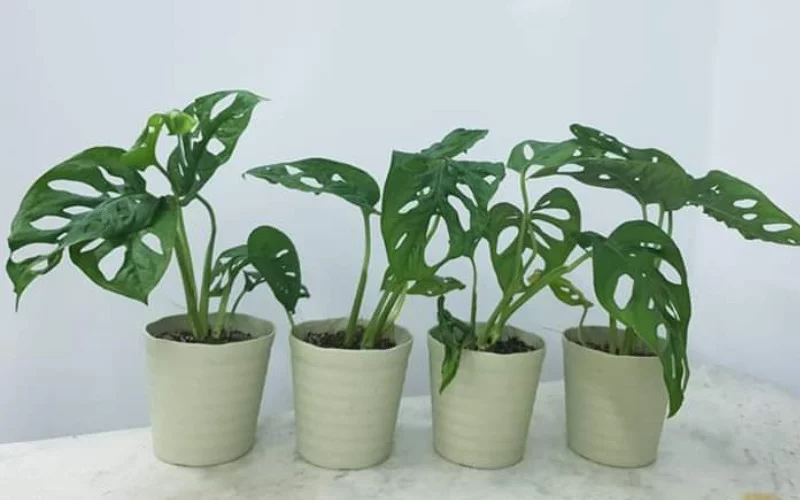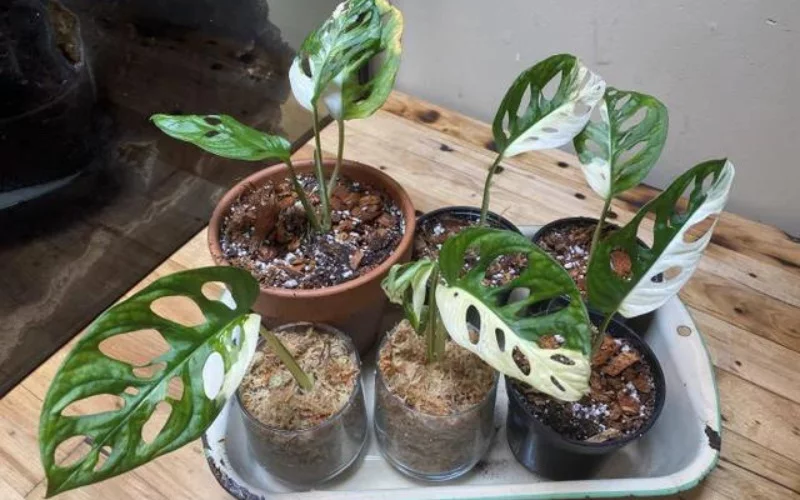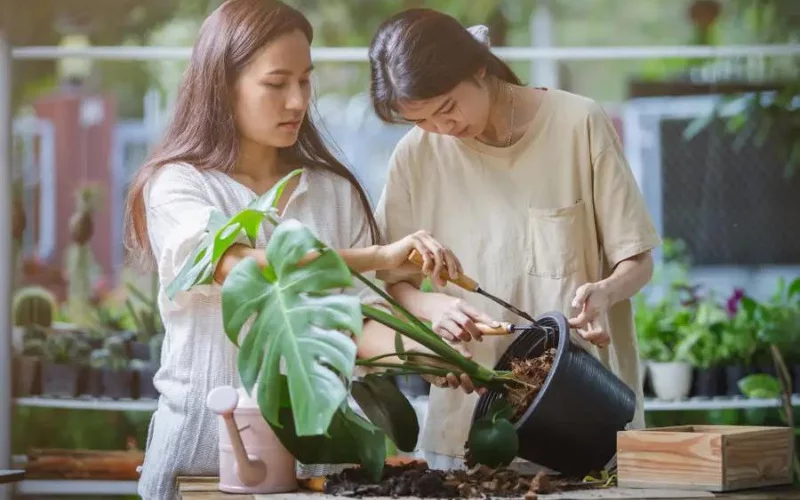Monstera adansonii, a uniquely beautiful plant that was fave a few decades ago, is back like it never left, and it is fast becoming a plant of choice for most gardeners.
This plant, commonly known as Swiss Cheese Plant, is vine-like and can grow into a lush ornamental for your home. There are 3 main ways of growing this crop, and the good news is that it is a beginner’s plant because it is easy to grow.
So whether you want to propagate your Monstera Adansonii by water, moss, or soil, you are in the right place for all you need to know about this aesthetically pleasing plant.
What’s Monstera Adansonii
Monstera adansonii is native to South and Central America, it is a member of the Araceae plant family, and they look very much like Monstera deliciosa, except for the fact that they don’t grow as large as monster deliciosa, neither are they edible and in place of the huge indents in their leaves, they rather have large oval holes as they mature, which is where it got its common name “Swiss cheese.”
The heart-shaped leaves can efficiently capture sunlight, and their holes(technically called fenestrations) become more distinctive on maturity. It thrives under part shade, and because of the holes in their leaves, they can withstand very windy conditions because the holes let the wind pass through them instead of blowing them away.
These plants with many cultivars (especially ‘Archipelago’ whose leaves are more stunning because they are variegated) develop cream-colored flowers with some hint of purple in the wild during spring.
They are climbers and produce aerial roots from their stems, which can grasp the bark of trees or foliage.
How To Propagate Monstera Adansonii
There are about 9 types of adansonii that there are, and each of them is propagated the same way and with ease. There are 3 ways of propagating this plant, and they are :
- Water propagation
- Soil propagation
- Moss propagation
It’s up to you to choose a method that works for you given the supplies you have at your disposal because each of them can be successful if done properly.
Propagation of Monstera Adansonii in Water

This is the easiest means of propagating this plant, especially if you are a beginner gardener. It allows you to grow without moss or soil; the input requirement is also minimal.
It takes about 12 days for this plant to produce roots in water and about a few weeks to even several months for the leaves to grow.
The only challenge unique to this propagation method is that it is susceptible to rot, so you have to keep an eye on the plant.
Propagation Procedure:
1. Choose a stem of monstera adansonii stem with 1 or 2 leaves and a node (node is the little brown bump on the stem) from a healthy plant, then use a sharp razor or a pair of shears to make the cutting.
The shear or razor must be sharp, clean, and sanitized with appropriate alcohol like isopropyl to take care of bacteria that might be left on the blade so that it doesn’t get transferred to your stem cutting and subsequently infect the new plant you are propagating.
2. Cut an inch below the last node that you will be propagating and place the stem in a water container whose temperature is slightly above room temperature. Make sure that all the nodes are submerged under water because this is where the roots of the plants will grow.
3. Ensure that none of the leaves are submerged underwater, so they don’t rot. You can use a shear to snip off any leaves submerged in water.
3. Then place the cutting in a warm and sunny area to get a lot of air and light.
4. You should change the water weekly to introduce fresh oxygen that the plant desperately needs, especially when the roots are getting established.
New leaves are about 4 inches in length, and roots will start shooting out in a matter of weeks, which means you have successfully propagated your monster adansonii.
5. You can now transfer your cutting from the water to the soil because the plant’s root is strong enough to be transplanted.
If, however, you do not want to transplant your monstera adansonii into the soil but leave it to grow in the water indefinitely, there are no problems with that, only that you must ensure that it gets the proper amount of sunlight and air circulation.
Monstera adansonii must also have enough room for the new roots o grow uninhibited. You will have to move the plant to a bigger container as the roots might outgrow the container. There are instances where gardeners have kept their monstera adansonii in water for 2 years before transplanting them to the soil.
Propagation of Monstera Adansonii in Soil

Propagating Propagation of Monstera Adansonii in the soil is the most common means of propagating this crop. It will take a maximum of 3 months to see any sign of growth, which is a little longer than the other methods.
Procedure:
1. Like the water propagation method, the first thing to do is choose a healthy monstera adansonii stem with 1 or 2 leaves and nodes.
2. Cut out 4 inches of this plant stem just below the first or second node from the top using a sterilized and sharp razor or shear to get a clean cut.
3. Gently push the cutting into the soil just below the soil line or just lay them on the top of the soil with the node facing downwards because the roots will only grow from the brown nodes, so they must be in contact with the soil directly.
4. Monstera adansonii needs a lot of good drainages to be rooted and even thrive, so you can use potting mix and add some peat moss and perlite for better aeration.
5. Your cutting requires at least 6 hours of sunlight daily, so you should place it where it can get that much sunlight.
Monstera adansoinii need a lot of water at this early stage of propagation. Hence, you need to water the newly planted cuttings until the soil is saturated and let it drain completely. You must ensure that the soil is moist all the time.
This plant also loves a humid environment, so you can place a plastic wrap or a clear bag over the top of the plant to ensure the humidity level is high, but you must take off this covering when you water the plants to prevent it rotting.
In a few weeks, all things being equal, you should see new roots and leaves growing. You can transfer it from the nursery to a permanent place when it is fully rooted. This should be in about 3 months from the time of the propagation.
Monstera adansonii Propagation In Moss

This method of monstera adansonii is not for amateur gardeners but for those who have some experience with aroids and air layering. When you propagate monstera adansonii in moss, you will likely end up with a hardy plant.
This propagation method is not very common, but it is equally effective because the moss acts as a soil-like medium that absorbs water well and stores it for the plant.
Procedure:
1. First, wrap a portion of the stem of the monstera adansonii ( the stem cutting you use must have at least a node or 2 in the stem) with sphagnum moss. You want to encase the stem so air cannot get in and dry the plant, or the propagation will fail. Leave it covered like that until new roots form.
2. Ensure that the moss completely covers your cutting, and then cover the entire thing in a plastic wrap to ensure that everything is in place and that the environment remains humid.
3. You should open it every week to see if it is still moist, and if it is drying out, you sprinkle some water to the point that the sphagnum moss is moist and not saturated.
4. In a matter of weeks, you should notice a few roots growing, and when this happens, you can cut the stem and transplant it.
READ: How To Care For A Monstera Adansonii
Tips Growing Monstera Adansonii
Here are a few things you can do to ensure that you not only propagate monstera adansonii successfully but always grow it in its permanent place:
1. Monstera adansonii can adapt to different light levels, it will do well initially in the shade, but as time goes on, they will require more light; hence you can leave it near the window if you are leaving the potted plant indoors.
2. The plant requires chunky, airy potting mixes for them to thrive. You can come up with a combination of potting mixes that is sure to allow oxygen to easily get into the mix.
3. Like most foliage plants, monstera adansonii need a 3-1-2 N-P-K ratio, meaning that any fertilizer you use should contain 3 parts nitrogen, 1 part phosphorus, and 2 parts potassium. These elements help your plant’s leaves, stems, and roots be healthy and grow well. You should apply this fertilizer once every 2 weeks in spring and summer and once in winter and Autumn.
4. The pot you use for monster adansonii should have holes for drainage, and they should not be porous like terra cotta. The pot size you use should be at least 2 inches wider than the root of the plant.
5. Monstera adansonii should be kept warm, and the temperature should not go below 60F, which is about 15.5°C.
Temperature And Humidity
As I always say, if you’re comfortable in your home, your plants probably will be too. Keep your Monstera adansonii on the warm size, and try not to go below a minimum of 60F (about 15.5C). This plant also needs increased humidity for it to thrive.
Some Common Challenges In Growing Monstera
Monstera adansonii is not a difficult plant to grow because once you follow the stipulated guideline on how to grow the crop, you will not have any issues. Here are a few problems you might encounter growing monstera adansonii:
1. Leaves With Brown Edge
Several things will cause your monstera adansonii to have brown edges, like when the potting mix is too dry or too wet (it causes the roots to rot), poor water quality, applying too much fertilizer, low humidity, and others. When you reverse these issues, the plant will return to normal, except it has had these challenges for too long.
2. Yellowing of leaves
So many things can cause the leaves of your beautiful monster adansonii to turn yellow, but the most common is an inadequate water supply. This is usually noticeable with the lower leaves of the vine. Deal with this problem by gently cutting off the yellowing leaves and watering the plants more frequently.
3. Droopy Plant
Too much or inadequate moisture will cause your monstera adansonii to droop, and you can reverse the situation by taking appropriate measures. If the soil is too dry, give it a good soaking, and in the case of very wet soil, don’t water it for some time and allow the soil to dry.
4. Mosaic virus
If your monstera adansonii has mottled leaves that are either yellow or white or have spots or streaks in the foliage, it probably has a mosaic virus. Another of these symptoms is stunted growth and twisted and deformed leaves. In this situation, you can isolate and quarantine this plant, so it doesn’t transmit to other plants.
Conclusion
The plant Monstera Adabsonii is as eccentric as the name sounds. The fact that it has fenestrations in its matured state is why many are crazy about this plant which can be propagated in water, on soil, and with moss, depending on your preference.
It is an easy plant to grow in as much as you provide it with the right growth condition. You are sure to propagate and grow to maturity you’re monstera adansonii.
Helpful Links:
- Tips for Growing Lavender in Florida
- Can You Dethatch St. Augustine Grass?
- 30 Amazing Flowers That Start With B
- How to Grow Yellow Daisies in Your Garden
- How to Grow Brussel Sprouts in Containers At Home
We trust this article helped you learn how to propagate Monstera adansonii. You may also want to check out How To Care For A Monstera Adansonii
Thanks for taking the time to read our article, and we hope you find it helpful. Would you mind leaving a comment below if you have any suggestions?
Kindly reach out to people by sharing this post on social media.
If you liked this article, then please follow us on Facebook, Instagram, Twitter, and Pinterest.

